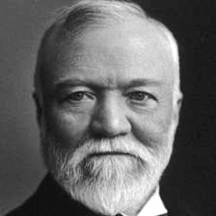 Andrew Carnegie |
|
Born on November 25, 1835 in Dunfermline, the medieval capital of Scotland, Andrew Carnegie is the embodiment of the American Dream. The son of poor Scottish immigrants, Andrew Carnegie literally went from “rags to riches” as he propelled his way forward with hard work and determination from a simple bobbin boy to Steel King and Richest Man in America. He was a Scottish-American industrialist who led the enormous expansion of the American steel industry in the late 19th century. He was also one of the highest profile philanthropists of his era; his 1889 article proclaiming "The Gospel of Wealth" called on the rich to use their wealth to improve society, and stimulated wave after wave of philanthropy. Background: Andrew Carnegie was the eldest son of William Carnegie, a linen weaver and local leader of the Chartists (who sought to improve the conditions of working-class life in Great Britain), and of Margaret Morrison Carnegie, daughter of Thomas Morrison, a shoemaker and political and social reformer. When steam-powered looms came to Dunfermline in 1847, hundreds of hand loom weavers, including William Carnegie, became expendable. Andrew’s mother, Margaret Morrison Carnegie, went to work to support the family, opening a small grocery shop and mending shoes. Fearing for the survival of their family, the Carnegies soon decided to leave Scotland, borrowing 20 pounds for passage to America. Upon arriving in 1848, the Carnegie family joined two of Margaret’s sisters in Pittsburgh, Pennsylvania. Life in America: It was in Pittsburgh, at the age of 13, that Andrew Carnegie began his career as bobbin boy in a cotton factory for $1.20 per week. A voracious reader, he took advantage of the generosity of Col. James Anderson who opened his library to local working boys. Books provided most of his education as he worked his way through a series of jobs from messenger boy in the city’s telegraph office to superintendent of the Western Division of the Pennsylvania Railroad. Andrew Carnegie, Steel King of America: Andrew Carnegie ultimately made his fortune in steel, turning the industrial world on its ear in the process. He introduced the Bessemer steel making process to America and, in 1875, opened his largest steel plant, the Edgar Thompson Works, in Braddock, Pennsylvania. In 1899, Carnegie joined several of his business interests by forming the Carnegie Steel Company, which immediately became a leader in the steel industry. Andrew Carnegie, Philanthropist: The empire he forged in the steel furnaces of Pittsburgh sold to J.P. Morgan in 1901 for $400 million and Andrew Carnegie retired from Business life as the richest man in the world. The man of steel, however, had a heart of gold. By the time of his death in 1919, Andrew Carnegie had given away over $350 million to provide more than 2,500 free public libraries throughout the world. Well remembered for his philanthropy and generous heart, Andrew Carnegie also gave money for museums and concert halls (including Carnegie Hall in New York City), and founded the Carnegie Institute of Technology in Pittsburgh (now Carnegie Mellon University). In his final days, Carnegie suffered from bronchial pneumonia. Before his death on August 11, 1919, Carnegie had donated $350,695,654 for various causes. The "Andrew Carnegie Dictum" was:
|
|
Previous Page |
Return Home |